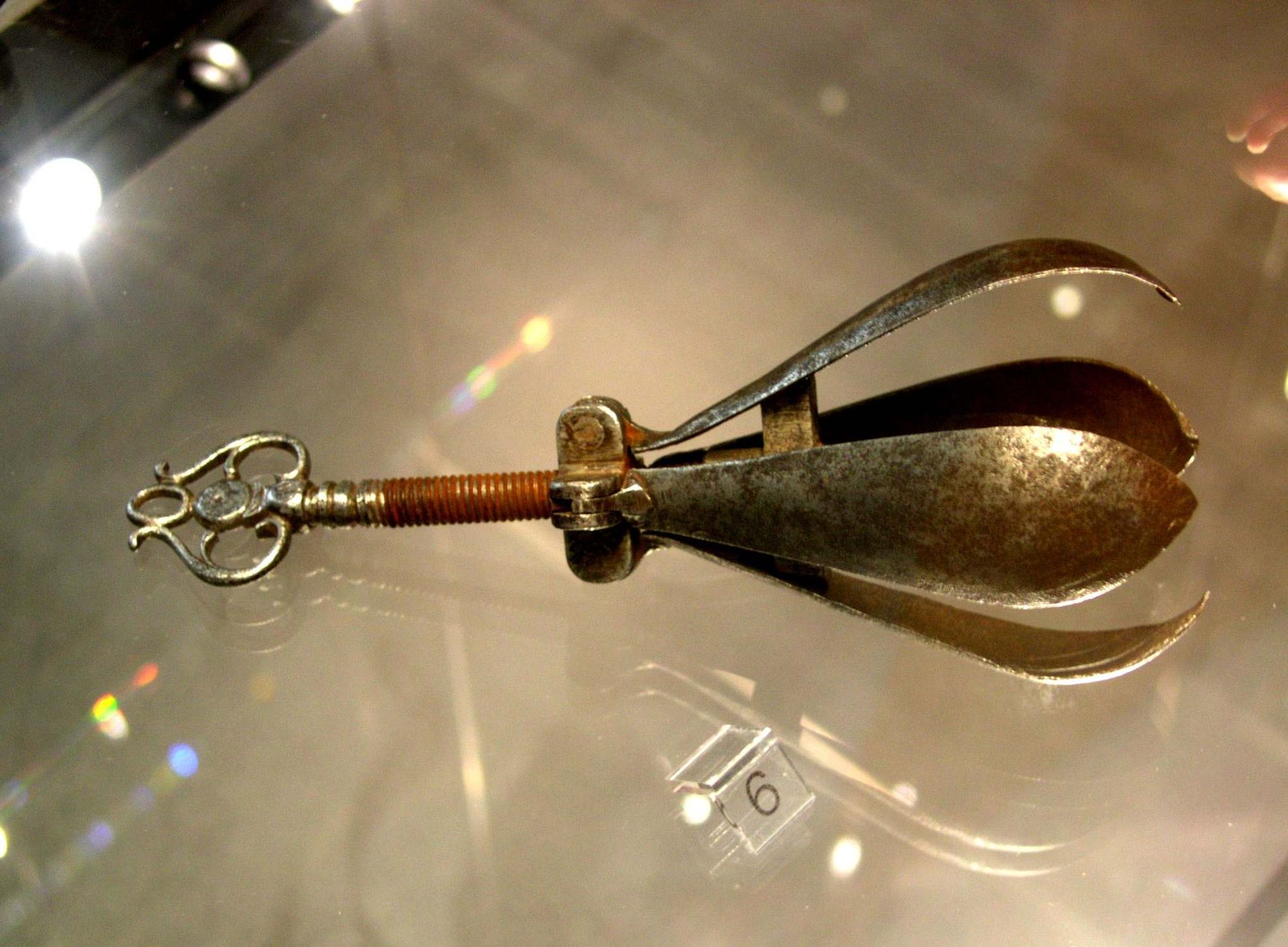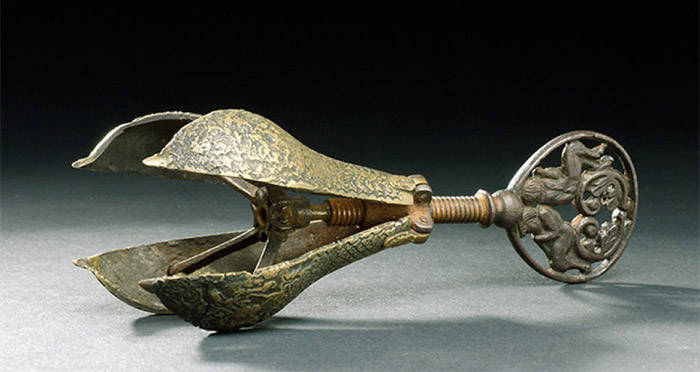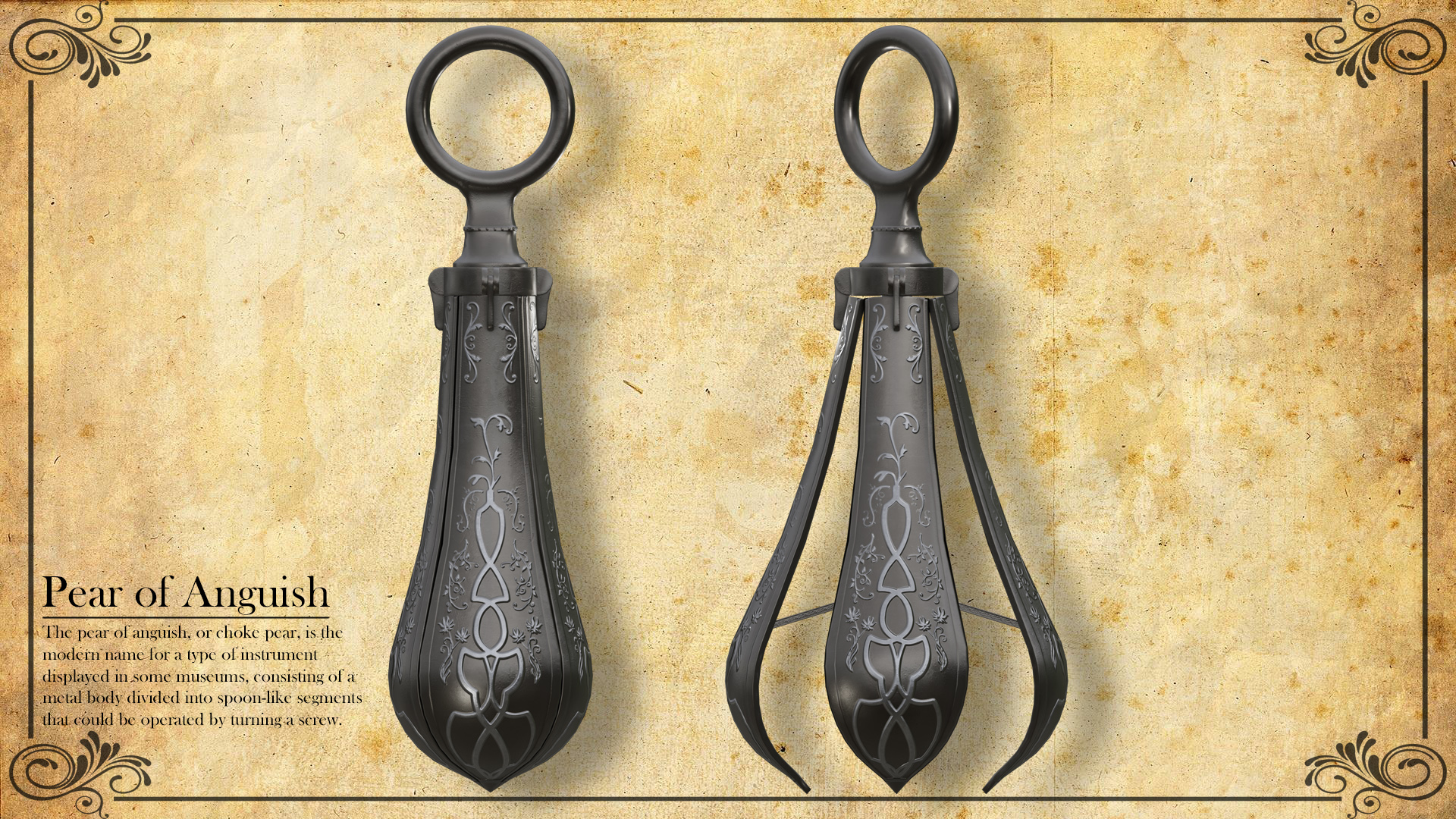The Pear Of Anguish - Fact Or Fiction In History
The idea of the "pear of anguish" often brings up images of dark, old times and cruel punishments. This particular instrument, with its peculiar shape, has certainly captured the interest of many people, appearing in stories and discussions about historical torment. Yet, it seems there's quite a bit more to this story than what first meets the eye, as a matter of fact. It turns out that much of what people think they know about this alleged device might be a bit of a tall tale, or at least, something that needs a closer look, you know.
What we're talking about here is a metal object, shaped somewhat like a fruit, that many believe was used to inflict great suffering. Stories suggest it was forced into different body openings and then expanded, causing a terrible, spreading pain. These tales usually place it squarely in the medieval period, often connected with the pursuit of witches or the punishment of various misdeeds, like lying or even what was then called blasphemy. It’s a very dramatic image, isn't it? One that really sticks with you, sort of.
However, when we start to really dig into the historical records, the truth about this so-called "pear of anguish" becomes a little less clear, more like a hazy picture, you know. There are many claims about its past, its supposed victims, and how it worked, but a lot of these claims don't quite stand up to careful examination. It’s a fascinating puzzle, actually, trying to sort out what’s real from what’s simply a chilling story that has grown over time, like your own shadow getting longer.
Table of Contents
- What Exactly Was the Pear of Anguish Supposed to Be?
- The Alleged Design of the Pear of Anguish
- Who Were the Supposed Victims of the Pear of Anguish?
- The Pear of Anguish and Accusations of Old
- Was the Pear of Anguish a Real Instrument of Pain?
- The Museum Displays of the Pear of Anguish
- Why Does the Idea of the Pear of Anguish Still Hold Our Attention?
- The Enduring Myth of the Pear of Anguish
What Exactly Was the Pear of Anguish Supposed to Be?
The "pear of anguish," sometimes called a choke pear or a mouth pear, is generally described as a metal device. Its form is said to resemble a pear, which is pretty distinctive, and it was designed with several parts, often called leaves or segments, that could spread apart. At one end, there was usually a handle with a screw. The idea was that as you turned the screw, these metal segments would slowly move away from each other, pushing outwards from the center, creating pressure and, supposedly, causing a great deal of discomfort or injury. This mechanical action, so it was told, was what made it such a feared item, in a way. It’s a simple but rather unsettling concept, isn't it?
The stories surrounding this particular piece of equipment suggest it was inserted into a person's body openings. This could mean the mouth, the anus, or for women, the vagina. Once placed, the turning of the screw would then cause the device to open up, stretching the internal tissues. This alleged process was meant to inflict extreme pain, and in some accounts, it would cause serious internal damage, perhaps leading to infections or, in the worst cases, even death. It sounds like something out of a very dark storybook, doesn't it? Just a little too dreadful to be true, you might think.
The Alleged Design of the Pear of Anguish
When you look at drawings or descriptions of the supposed "pear of anguish," you see a very specific kind of construction. It's often depicted as having four segments, or leaves, that come together to form the pear shape when closed. These segments are hinged at one end and connected to a central rod at the other. The rod, in turn, connects to the screw mechanism at the handle. This setup, quite honestly, makes it seem like a plausible, if horrifying, machine for stretching things. The metal would have been cold and hard, which would add to the overall unpleasantness, you know. It’s a very stark image, in some respects.
The idea of a device like this, slowly expanding inside a person, really taps into a deep-seated fear of internal harm. The pain would not be immediate but would build, growing steadily as the screw was turned. This kind of slow, building torment is often considered more cruel than a quick, sharp blow. It’s a pretty unsettling thought, actually, how such a thing could be conceived, even if it was just in the minds of storytellers. The alleged design of the pear of anguish, with its simple yet effective method of expansion, certainly makes it a memorable, if fictional, piece of torture lore, more or less.
Who Were the Supposed Victims of the Pear of Anguish?
The tales about the "pear of anguish" often name specific groups of people as its unfortunate targets. Many stories claim it was used on women accused of witchcraft, which was a big fear during certain historical periods. Other accounts suggest it was for those accused of causing a miscarriage. Beyond that, people who were thought to be lying or speaking against religious beliefs, often called blasphemers, were also said to face this device. It seems, too, that homosexual individuals were sometimes mentioned as victims, with the device supposedly used in different body openings depending on the alleged wrongdoing. This shows a very specific kind of social control, doesn't it? A pretty harsh one, I mean.
The idea that this device was used to extract confessions is also a common thread in these stories. If someone was suspected of a crime or heresy, the threat, or even the use, of such a painful instrument might make them admit to anything, just to make the suffering stop. This reflects a time when legal processes were very different, and the truth was often sought through extreme measures, rather than through careful investigation or fair trial. It paints a rather grim picture of justice, so it does, where fear was a primary tool, basically.
The Pear of Anguish and Accusations of Old
When we look at the specific accusations tied to the "pear of anguish," we see a pattern reflecting the anxieties and moral codes of the past. Women accused of witchcraft were often seen as a threat to society, and any unusual behavior or misfortune might be blamed on them. Similarly, miscarriages, which were not well understood, could lead to accusations of dark practices. Lying and blasphemy were considered grave offenses, threatening the social order and religious authority. It’s pretty clear that the alleged use of this device was tied to maintaining a very strict set of rules, you know. A sort of brutal way to enforce conformity, one might say.
The connection to the Spanish Inquisition in some narratives is also worth noting, though again, this is largely part of the myth. The Inquisition was known for its severe methods in dealing with heresy, and any story of extreme torture often gets linked to it. The "pear of anguish" fits right into this narrative of severe punishment and forced confessions. It’s a powerful image, really, that helps illustrate the fears people had about these historical institutions. The idea of such a tool being used in such contexts just adds to the chilling nature of the stories, doesn't it? It’s a very vivid picture, actually.
Was the Pear of Anguish a Real Instrument of Pain?
This is where the story of the "pear of anguish" gets a bit complicated, you know. Despite its frequent appearance in popular culture and horror stories, historical experts and researchers generally agree that there is very little solid proof that this device was ever actually used as a torture instrument. The accounts describing its use are often doubtful, coming from sources that are not always reliable, or they appear to be modern creations. It seems that many of the stories about its widespread use in the medieval period, or even during the Spanish Inquisition, are simply not supported by the kind of evidence we would expect to find for a real, common tool of torment. It's a bit of a letdown for those who love a good gruesome tale, but it's the truth, more or less.
Many of the supposed "pears of anguish" displayed in museums today are thought to be fakes, or at least, objects that were not originally designed for torture. Some might have been surgical instruments, or even tools used for stretching or opening things in a non-torturous context. The idea that someone like Palioly, a French villain from the 17th century, invented it, also adds to the fictional feel. It suggests a specific origin story, but without strong proof, it remains just a story. It's almost as if the idea of it was so compelling, people wanted it to be real, or at least, wanted to believe in its existence, basically.
The Museum Displays of the Pear of Anguish
You might find what looks like a "pear of anguish" in some museums that feature historical instruments or torture devices. However, curators and historians who specialize in these areas often point out that these items have a "fishy smell about them," as one source puts it. This means there's a strong suspicion that they are not genuine torture tools from the medieval period. Many could be later fabrications, created to meet a public fascination with the macabre, or perhaps they were originally designed for other, less sinister purposes. It's pretty common for museums to have items that are misidentified or whose history is not fully clear, you know. It’s a tricky business, verifying old objects.
The lack of contemporary records describing the "pear of anguish" as a widely used torture device is a big red flag. Unlike other, well-documented instruments of pain from the past, there aren't many reliable historical documents, court records, or detailed accounts from the time that mention this specific "pear" being used for punishment. This absence of proof makes it highly likely that the "pear of anguish" is more of a legendary item, a product of later sensationalism, rather than a true piece of historical torture equipment. It’s a bit like a ghost story that everyone tells, but no one has actually seen the ghost, you know. It still makes for a good story, though, doesn't it?
Why Does the Idea of the Pear of Anguish Still Hold Our Attention?
Despite its doubtful historical authenticity, the "pear of anguish" continues to fascinate people. Part of its lasting appeal probably comes from its truly gruesome nature and the vivid images it conjures. The idea of a device that slowly expands inside a person to cause immense pain is, quite honestly, a deeply unsettling thought. It taps into our fears about vulnerability and physical suffering. This kind of chilling concept tends to stick in our minds, making it a popular subject in books, movies, and other forms of entertainment that explore the darker aspects of history or human behavior. It’s a very potent image, really, that speaks to something primal within us, so it does.
The enduring myth of the "pear of anguish" also highlights how easily misinformation can spread and become accepted as fact, especially when it involves sensational or shocking details. Stories of extreme torture from the "dark ages" fit a certain narrative about the past, one where life was brutal and punishments were incredibly cruel. Even if the specific instrument wasn't real, the broader context of severe historical punishments was, which helps the myth take root. It’s almost as if the myth serves as a stand-in for the general brutality of certain periods, you know. A kind of symbol, if you will, for a very harsh time.
The Enduring Myth of the Pear of Anguish
The "pear of anguish" has a powerful legacy, not as a proven historical tool, but as a chilling symbol. It represents the dark side of human cleverness, the capacity for inventing ways to inflict suffering, even if in this case, the invention was mostly in the realm of storytelling. It reminds us of the terrible things that were believed about people accused of various "crimes" in the past, and the lengths to which societies might go to enforce their rules. The persistent interest in this device, even as its historical reality is questioned, shows how compelling these tales of historical horror can be. It's a very striking example of how myths can shape our perception of the past, isn't it? And how they can continue to hold a strange sort of power over our imaginations, basically.
So, while the "pear of anguish" might not have been a real, widely used torture instrument, its story serves a purpose. It helps us remember the often brutal nature of justice in earlier times and the fears that gripped societies. It also makes us think about how stories are made and passed down, sometimes growing larger and more dramatic with each telling, even when the initial facts are thin. It’s a fascinating look at how history, or at least the idea of history, gets shaped by both truth and powerful, unsettling narratives, you know. And that, in itself, is a pretty compelling story.



Detail Author:
- Name : Miss Eileen Graham IV
- Username : layne38
- Email : keven99@yahoo.com
- Birthdate : 1979-03-24
- Address : 8764 Kovacek Fork Suite 044 Mullerport, AK 76744
- Phone : +1-251-413-8674
- Company : Pagac, Farrell and Mante
- Job : Community Service Manager
- Bio : Sapiente sapiente autem autem quis numquam quisquam. Nobis magnam recusandae assumenda quam ipsa. Natus dolorum rerum non quia voluptatum impedit in. Fugit inventore et autem nemo.
Socials
facebook:
- url : https://facebook.com/altheaarmstrong
- username : altheaarmstrong
- bio : Eos magni accusantium non repellendus laudantium.
- followers : 1662
- following : 2725
tiktok:
- url : https://tiktok.com/@althea.armstrong
- username : althea.armstrong
- bio : Earum at commodi quidem vitae et corporis. Maxime amet eligendi et rerum.
- followers : 6475
- following : 1195